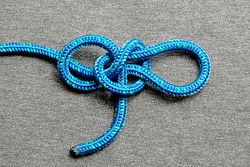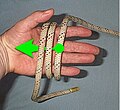| Angler's loop | |
|---|---|
 | |
| Names | Angler's loop, Perfection loop |
| Category | Loop |
| Releasing | Jamming |
| Typical use | Fishing, forming a fixed loop in bungee cord |
| ABoK | #1017, #1035, #2067 |
| Instructions | |
An angler's loop, otherwise known as a perfection loop, is a type of knot which forms a fixed loop. Useful for fine or slippery line, it is one of the few loop knots which holds well in bungee cord. It is quite secure, but it jams badly and is not suitable if the knot will need to be untied. [1]














